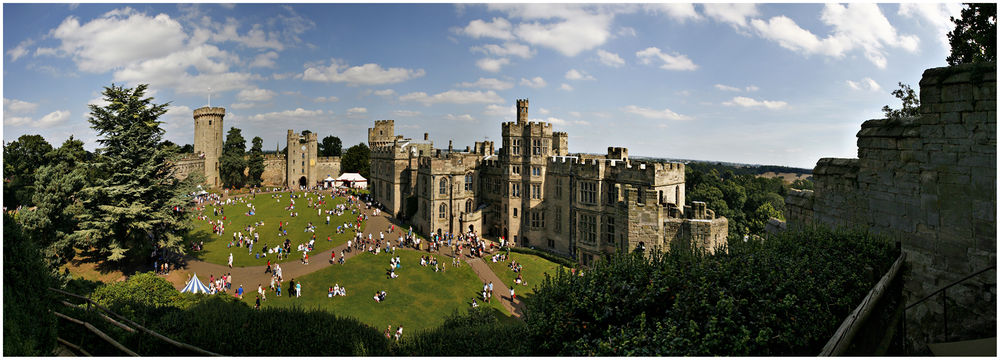Warwick
| Warwick | |
A view over Warwick |
|
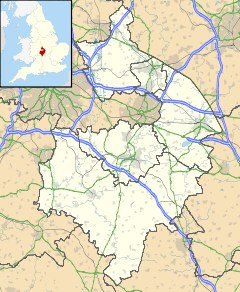 Warwick
|
|
| Population | 25,434 |
|---|---|
| OS grid reference | |
| Parish | Warwick |
| District | Warwick |
| Shire county | Warwickshire |
| Region | West Midlands |
| Country | England |
| Sovereign state | United Kingdom |
| Post town | WARWICK |
| Postcode district | CV34 CV35 |
| Dialling code | 01926 |
| Police | Warwickshire |
| Fire | Warwickshire |
| Ambulance | West Midlands |
| EU Parliament | West Midlands |
| UK Parliament | Warwick and Leamington |
| List of places: UK • England • Warwickshire | |
Warwick (pronounced /ˈwɒrɪk/ (![]() listen) WORR-ik with a silent w in the middle) is the county town of Warwickshire, England. The town lies upon the River Avon, 18 km (11 miles) south of Coventry and 4 km (2.5 miles) west of Leamington Spa (although the towns are conjoined), with a population of 25,434 (2001 census).[1]
listen) WORR-ik with a silent w in the middle) is the county town of Warwickshire, England. The town lies upon the River Avon, 18 km (11 miles) south of Coventry and 4 km (2.5 miles) west of Leamington Spa (although the towns are conjoined), with a population of 25,434 (2001 census).[1]
Contents |
Culture
Warwick hosts annual festivals ranging from the Spoken Word to Classical and Contemporary Music to a Folk Festival and a Victorian Evening, held in late November or early December. St. Mary's Church hosts a series of Early Music concerts, and the Bridge House Theatre hosts the Music-in-Round concerts. Warwick Chamber of Trade helps to promote the town for visitors, residents and businesses. The town is also famous for Warwick Castle, the construction of which began in 1068. The town centre is also known for its historic architecture and contains a mixture of Tudor and 17th-century buildings. In recent years several high-profile national and international companies have set-up large office complexes in and around Warwick, notably National Grid plc and IBM.
Warwick is also known for Warwick Racecourse, near the west gate of the medieval town, which hosts several televised horse racing meetings a year. Within the racecourse is a small golf course. Warwick Hospital, Royal Leamington Spa Rehabilitation Hospital and St Michael's Hospital (a psychiatric that superseded Central Hospital, Hatton) are situated within the town.
Warwick is twinned with Saumur in France and Verden, Germany. Warwick was twinned with Saumur in 1976. Verden, already the twin town of Saumur, became Warwick's German partner in 1989. Havelberg, in the former East Germany was adopted by Verden on re-unification, and was welcomed as a friendship town by Warwick and Saumur. As part of Warwick District, the town participates in One World Link (OWL), a friendship link with Bo in Sierra Leone.
History

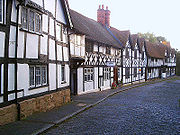
Anglo-Saxons
According to the Anglo Saxon Chronicle, Warwick was founded on the banks of the River Avon in the year 914 AD when Anglo Saxon Ethelfleda Lady of the Mercians, sister of king Edward the Elder of Wessex built a burh or fortified dwelling to overwhelm the Danish (Vikings) who had settled in what had been the old Mercian kingdom. She was the widow of Alderman Aethelred her father, king Alfred's ally. This burh was the early origins of Warwick Castle.[2] The name 'Warwick' means "dwellings by the weir".
Vikings
In 1050 the Danes (Vikings) invaded Mercia and burned down much of Warwick including the nunnery (which stood on the site of the present day St Nicholas Church).[3] Its fortifications led Warwick to become the administrative centre of the new shire in the united English kingdom, and the shire administered from Warwick became known as Warwickshire.
Mercia
In medieval times, Warwick remained under the control of various Earls of Warwick, mostly of the Beauchamp family, becoming a walled town. Today the only remains of the town walls are the east and west gatehouses. The eastern gatehouse now serves as part of the King's High School, a sister institution to Warwick School. Warwick was not incorporated as a borough until 1545.[3] The town's Priory was founded in 1142 on the site of the current Priory Park.

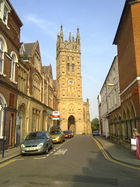
During the English Civil War the town and castle were garrisoned for Parliament. The garrison, under Sir Edward Peyto, withstood a two week siege by the Royalists. Later musters from 1644 to 1646 record a garrison of up to 350 men under the command of Colonel William Purefoy and Major John Bridges. The middle of the 17th century also saw the founding of Castle Hill Baptist Church, one of the oldest Baptist churches in the world.
Fire
In 1694 a great fire destroyed much of the medieval town and as a result most of the buildings in the town centre are of 17th and 18th century origin, although a number of older medieval timber framed buildings survive, especially around the edges of the town centre.[2]
The fire burnt down much of the medieval church of St Mary; both the chancel and the Beauchamp Chapel, however, survived, the latter having been built between 1443 and 1464 according to the wishes of Richard Beauchamp, Earl of Warwick (who had died in Rouen in 1439). A full size reclining copper gilt effigy of the Earl lies upon his Purbeck marble tomb - a fine piece of medieval metalwork cast in 1459.
Governance
Population growth has led to Warwick becoming joined to its larger neighbouring town Leamington Spa with which it forms a small conurbation. Both towns are now administered as part of the Warwick District, which has its headquarters in Leamington, although each retains a separate town council. Warwickshire County Council remains based in Warwick itself.
Chris White, of the Conservative Party, is Member of Parliament for the Warwick and Leamington constituency.
Geography
Suburbs
Suburbs of Warwick include Bridge End, Emscote, Forbes, Myton (connecting Warwick with Leamington Spa), Packmores, The Cape, Warwick Gates, Woodloes Park and the newly established Chase Meadows.
Warwick Gates
Warwick Gates is a newly developed housing estate and business park in Heathcote, south-west Warwick. Although separated from Warwick town centre by open fields, Warwick Gates falls within the Warwick South and Bishops Tachbrook parish. It is adjacent to Whitnash, a small town near Leamington Spa, and nearby the village of Bishops Tachbrook. The Tachbrook Park and Heathcote industrial estates are located nearby. The Royal Leamington Spa Rehabilitation Hospital is adjacent to Warwick Gates.
Landmarks
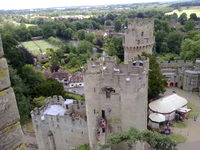
- Market Hall
- Warwick Castle
- Lord Leycester hospital
- Warwick School
- Guy's Cliffe House
- Warwick Hospital, Lakin Road
- Lord Leycester hotel
- Collegiate Church of St Mary
- The Dream Factory
- Saxon Mill
- St. Nicholas' Park
- Bridge House Theatre
Transport
Warwick is near the M40 motorway and the A46 trunk road.
The town also has good rail links, with direct rail services to Leamington Spa, London, Birmingham and Stratford-upon-Avon provided by Chiltern Railways from Warwick railway station in the town and also from Warwick Parkway, an out-of-town station opened in 2000 a few miles from the town. In addition, a few peak-hour trains to and from Birmingham are operated by London Midland.
Regular bus services to Leamington Spa, Stratford-upon-Avon and Coventry are operated by Stagecoach in Warwickshire from the bus station in the town centre.
There is also a National Express coach stop in the town with limited services. The nearby Warwick Parkway railway station also has a coach stop with more frequent services.
The Grand Union Canal and the River Avon also pass through the town. The restored Saltisford Canal Arm, is close to the town centre, and is a short branch of the Grand Union Canal. The arm is the remains of the original terminus of the Warwick and Birmingham Canal and dates back to 1799. The Saltisford Canal Trust have restored most of the surviving canal, which is now the mooring for colourful narrowboats and a waterside park open to the public. Over 800 visiting narrowboats come by water to Warwick each year and moor on the arm.
Education
There are a number of secondary schools located within Warwick, including Warwick School, an independent school for boys, The King's High School For Girls, an independent school for girls, Myton School and Aylesford School, both of which are state run co-educational schools.
Warwick School
Warwick School is an independent school for boys which claims to be the oldest boys' school in England. The actual date of its founding is unknown, although 914 has been quoted in some cases. For some years the school honoured the fact that King Edward the Confessor (c.1004–1066) chartered it, although there is no direct evidence for this, and King Henry VIII re-founded the school in 1545. Whatever the truth of the matter, there is no doubt that there has been a grammar school in the town of Warwick since before the Norman Conquest, and its successor, the present independent school, has been on its current site south of the River Avon since 1879.
University of Warwick
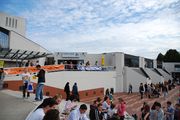
The University of Warwick is somewhat confusingly named after the county of Warwickshire, rather than the town, and is in fact situated several miles north of Warwick on the southern outskirts of Coventry, near Kenilworth. Adding to the location confusion is the fact that Coventry is no longer in the county of Warwickshire, but instead is in the West Midlands, leading to the current situation where the university straddles both counties.
Economy
Due to its proximity to north-south and east-west motorway routes, many companies have their head office in the town. Since November 2004, National Grid plc has had its National Gas Control Centre (NGCC) for the National Transmission System on the Warwick Technology Park south of the town between the A425 road and A452 road. ConocoPhillips and their petrol station group, JET, have their UK base also on the Technology Park. IBM and Volvo Group UK have bases on the Wedgnock Industrial Estate in the north of the town, near to the A46 trunk road.
Public services
Warwick Hospital, Royal Leamington Spa Rehabilitation Hospital and St Michael's Hospital (a psychiatric that superseded Central Hospital, Hatton) are situated within the town.
Town twinning
 Warwick, Rhode Island, USA
Warwick, Rhode Island, USA Saumur, Pays de la Loire, France
Saumur, Pays de la Loire, France Verden, Lower Saxony, Germany
Verden, Lower Saxony, Germany Warwick, New York, USA
Warwick, New York, USA Warwick, Queensland, Australia
Warwick, Queensland, Australia
Associations
J. R. R. Tolkien seems to have been very influenced by Warwick (where he was married in the Catholic church of Saint Mary Immaculate) and by its Mercian connections: Lynn Forest-Hill, in an article in the Times Literary Supplement (TLS 8 July 2005 pp 12–13) argues cogently that two important settlements in Tolkien's work were modelled on Warwick — Edoras closely on the early town, and Minas Tirith more remotely on the Norman; and that aspects of the plot of The Lord of the Rings are paralleled in the romance known as Guy of Warwick.
Warwick and its historic buildings have featured in a number of television series, including the BBC's drama series Dangerfield, the period dramas Pride and Prejudice and Tom Jones and Granada Television's Moll Flanders. Parts of the town subbed for Elizabethan and Jacobean era London in the third-series episode two (The Shakespeare Code) of Doctor Who which ran 7 April 2007.
Warwick has many long established sports clubs including Warwick Hockey Club which was founded in 1920 and Racing Club Warwick F.C. founded a year earlier.
Notable people
- Edgar Broughton Band (rock band)
- John Fairfax (journalist)
- Margaret Harrington (Canadian politician)
- Sir John Hicks (winner of Nobel Prize in Economics)
- Robert Eyres Landor (1781–1869, playwright and poet)
- Walter Savage Landor (1775–1864, poet)
- June Tabor (folk singer)
- Simon Taylor-Davis (lead guitarist of rock band Klaxons)
- Naomi Freeth (pop singer)
References
External links
- Building History entry for Warwick
- Warwick at the Open Directory Project
- Enjoy Warwick — An invaluable reference to the unspoilt town of Warwick
- Warwickshire's Railways — the history of the county's railways from 1838 to 1968
- Warwick Tourist Information Centre
- A collection of photographs of Warwick
- Views of Warwick in Old Postcards
- Warwick Pageant 1906
- Saltisford Canal Trust: Warwick's local waterway charity
- Photos of Warwick and surrounding area on geograph
|
||||||||||||||||||
|
||||||||||||||
